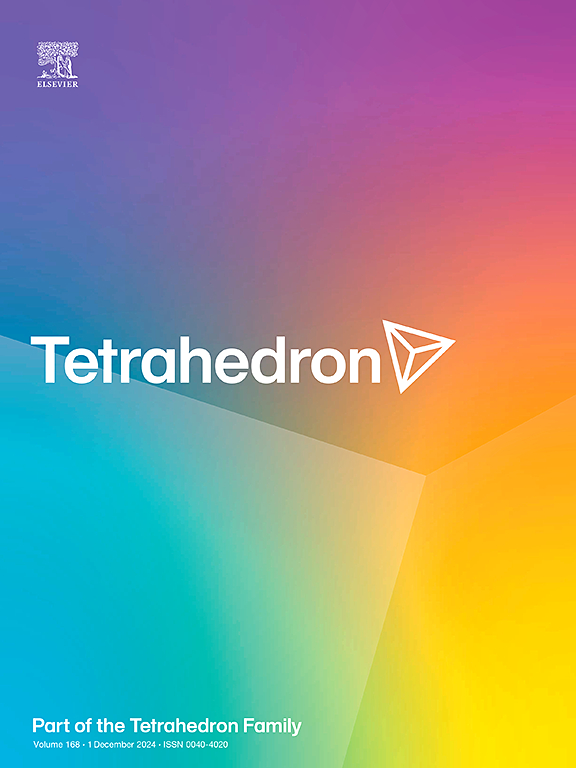IF 2.1
3区 化学
Q2 CHEMISTRY, ORGANIC
引用次数: 0
摘要
我们开发了一种合成双苯并噻吩[b]融合 BODIPYs 的新方法,利用 Pd(PPh3)2Cl2 作为催化剂,实现了四卤代 BODIPY 的区域选择性催化环化,以高产率(70-77%)生成了三种新的近红外(NIR)荧光染料 BBTB-1、BBTB-2 和 BBTB-3。这一进步不仅提高了合成效率,而且为设计具有微调光电特性的 BODIPY 染料提供了新的可能性。X 射线晶体结构显示了其优异的平面 π 共轭性。与带有电子捐献基团的 BBTB-3 相比,在中位带有电子抽离基团的双苯并噻吩[b]融合 BODIPY(BBTB-1 和 BBTB-2)的光物理和电化学分析表明,其吸收光谱和荧光光谱都发生了红移,LUMO 能级降低,HOMO-LUMO 间隙缩小。值得注意的是,BBTB-1 和 BBTB-2 的 LUMO 能级分别降低到了 -3.81 和 -3.83 eV。这些双苯并噻吩[b]融合 BODIPYs 的优异特性有望拓宽它们的潜在应用领域,尤其是在有机半导体材料中,因为这些材料的光电特性对提高性能至关重要。本文章由计算机程序翻译,如有差异,请以英文原文为准。
![Efficient synthesis and properties of bis-benzothiophene[b]-fused BODIPY dyes via Pd(PPh3)2Cl2-catalyzed regioselective cyclization](https://img.booksci.cn/booksciimg/2025-2/99296587561768748164.jpg)
Efficient synthesis and properties of bis-benzothiophene[b]-fused BODIPY dyes via Pd(PPh3)2Cl2-catalyzed regioselective cyclization
A new method for synthesizing bis-benzothiophene[b]-fused BODIPYs has been developed, enabling the regioselective catalytic cyclization of tetrahalogenated BODIPY, yielding three new near-infrared (NIR) fluorescent dyes, BBTB-1, BBTB-2 and BBTB-3, with high yields (70–77 %) using Pd(PPh3)2Cl2 as a catalyst. This advancement not only enhances synthesis efficiency but also opens new possibilities for designing BODIPY dyes with finely tuned optoelectronic properties. X-ray crystal structure exhibited their excellent planar π-conjugation. Compared to BBTB-3 with electron-donating groups, photophysical and electrochemical analyses of these bis-benzothiophene[b]-fused BODIPYs with electron-withdrawing groups at the meso-position (BBTB-1 and BBTB-2) demonstrated red-shift in both absorption and fluorescence spectra, and a reduction in LUMO energy level and a narrowed HOMO-LUMO gap. Notably, the LUMO energy level of BBTB-1, BBTB-2 were reduced to −3.81 and −3.83 eV, respectively. The exceptional properties of these bis-benzothiophene[b]-fused BODIPYs are expected to broaden their potential application, particularly in organic semiconductor materials, where such optoelectronic characteristics are crucial for enhancing performance.
求助全文
通过发布文献求助,成功后即可免费获取论文全文。
去求助
来源期刊

Tetrahedron
化学-有机化学
CiteScore
3.90
自引率
4.80%
发文量
439
审稿时长
34 days
期刊介绍:
Tetrahedron publishes full accounts of research having outstanding significance in the broad field of organic chemistry and its related disciplines, such as organic materials and bio-organic chemistry.
Regular papers in Tetrahedron are expected to represent detailed accounts of an original study having substantially greater scope and details than that found in a communication, as published in Tetrahedron Letters.
Tetrahedron also publishes thematic collections of papers as special issues and ''Reports'', commissioned in-depth reviews providing a comprehensive overview of a research area.
 求助内容:
求助内容: 应助结果提醒方式:
应助结果提醒方式:


